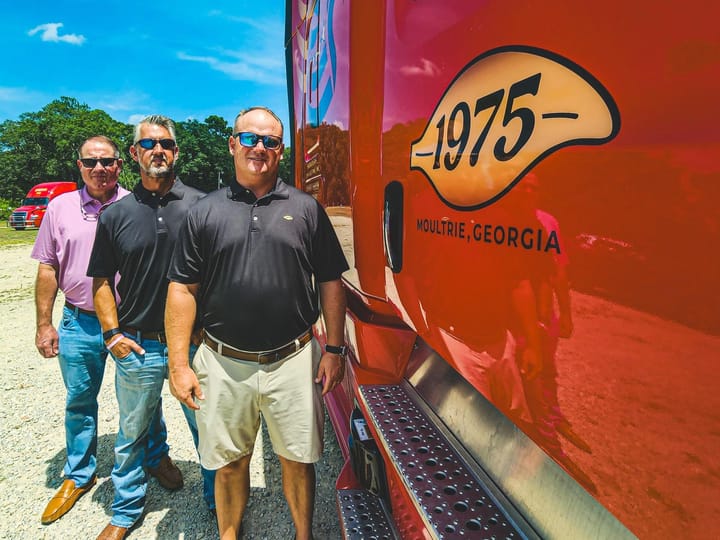Under 21 and Driving a Rig: Federal apprenticeship trains young truckers
Facing a critical shortage, the American trucking industry sees a ray of hope in young drivers through the Safe Driver Apprenticeship Pilot program, aiming to bolster the workforce and sustain supply chains.

By Emily Paul, for The Inside Lane
Facing a critical shortage of truck drivers that threatens to disrupt supply chains nationwide, the American trucking industry is at a crossroads.
As demand for drivers soars, an unlikely group may hold the key to sustaining America's pipeline: young drivers.
Enter the Safe Driver Apprenticeship Pilot (SDAP) program, a transformative federal initiative aimed at unlocking the potential of aspiring truckers ages 18-20.
One of them is Ulysses Mota, a 20-year-old dreaming of joining his family's trucking business, Husky Trucking, in Fort Lupton, Colorado. Hindered by age restrictions that have long kept eager young adults like Mota on the sidelines, SDAP offers a glimmer of hope and a direct path into the heart of the industry.
“A program like this is definitely an advantage to us,” Mota said. “It’s a step in that direction even if we don’t have much experience.”
Mota explained that his current job requires him to be away from home for weeks at a time. Obtaining a commercial driver's license would change his schedule, allowing him more time with his young family.
The American Trucking Associations predicts a need to hire over one million new drivers in the next decade to keep up with industry demands. An aging workforce, lifestyle challenges of the job and retention issues currently plague the industry.
Program struggles to take off
The SDAP program, introduced in July 2022 as part of the Bipartisan Infrastructure Law, allows qualified drivers aged 18-20 to operate in interstate commerce under specific conditions.
This three-year program allows young drivers to explore trucking industry careers and allows carriers to hire and train new young drivers. Before SDAP, CDL holders had to be at least 21 years old to work in interstate commerce.
With the industry’s driver shortage, the introduction of SDAP could be a step in the right direction.
That is if more young drivers and trucking firms would enter the program.
Despite the Biden administration's expectations for 1,000 fleets to participate and a cap set at 3,000 drivers, actual enrollment figures are disappointingly low. The program had only 34 approved carriers and 36 apprentices, according to its 2023 report.
Hurdles like insurance, safety equipment requirements and low engagement have plagued the program.
This month, the Federal Motor Carrier Safety Administration sought emergency approval from the White House Office of Management and Budget to amend the SDAP, ensuring compliance with the recently passed Consolidated Appropriations Act of 2024.
The spending bill restricts the FMCSA from mandating inward-facing cameras and apprenticeship registration with the Department of Labor for SDAP eligibility.
That could change the program's popularity, and easing the restrictions could mean more participation.
Benefits and breaking down barriers
The SDAP program offers potential solutions to the nation’s driver shortage through early and thorough training and closes the eligibility gap for young people interested in trucking.
Cicely Waters, director of the Office of Communications for the FMCSA, said the program provides an opportunity for carriers to engage with the next generation of drivers in a safe and productive way.
Mackenzie Melton, safety director at Garner Trucking in Findlay, Ohio, said the program closes a gap where young people interested in trucking can join the industry before turning 21.
Garner Trucking currently has three apprentices from SDAP in its fleet.
“There’s no difference between the younger drivers versus other drivers of different ages. They are well-trained, excited to join the career, anxious to learn and they soak up knowledge like sponges,” Melton said. “They are so excited for the opportunity that wasn’t available before.”
Shawn Coyle, safety manager of Badger Express in Fall River, Wisconsin, said with the driver shortage, SDAP provides a way for the company to recruit new drivers to fill its needs.
Although Badger Express was only in a position to hire a single apprentice, Coyle said their SDAP participant has been with them for a year and is a great addition to their team.
Carrier Concerns
While fleets like Badger Express were well set up to be approved to participate in the program, other carriers may not have it as easy. Not all carriers have the advanced safety equipment or insurance approval required by the FMCSA.
“The biggest hurdle to carriers wanting to get into this program is that it requires some equipment that they may not want to get into, and the other thing is insurance approval to bring on a driver with little to no experience,” Coyle said.
“A lot of insurance companies balk at that. We had a good safety record, and they gave us a shot.”
To participate in the program, the FMCSA requires certain criteria to be met by carriers, apprentices and experienced drivers.
Once approved, apprentices will serve two probationary periods with an experienced driver in the passenger's seat while the apprentice is behind the wheel. At least 400 hours of on-duty time must be completed during the probationary periods, with at least 240 of those hours being driving hours, before an apprentice may drive on their own.
The FMCSA will also collect data from the apprentices on the safety of younger drivers involved in interstate commerce. According to its website, the FMCSA will continue to collect data from these drivers until they age out of SDAP “to better understand whether preventative actions can be taken to decrease crashes involving CMSs and young drivers.”
The hope for the program remains, despite the setbacks.
“Motor carriers can fill driver shortages, train and hire new drivers and retain talent,” Waters said. “And Americans can continue to receive their goods via our nation’s dedicated trucking and transportation professionals. A true win-win!”
Have a question or comment about this article? Email Bianca Prieto at editor@theinsidelane.co
Not yet a subscriber? Join here.





Comments ()